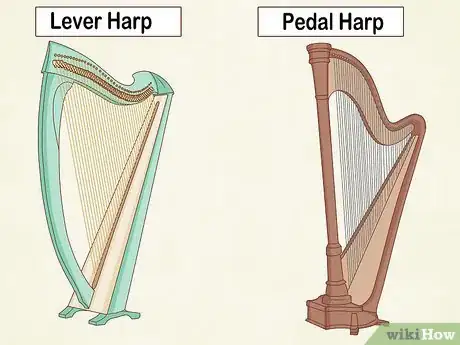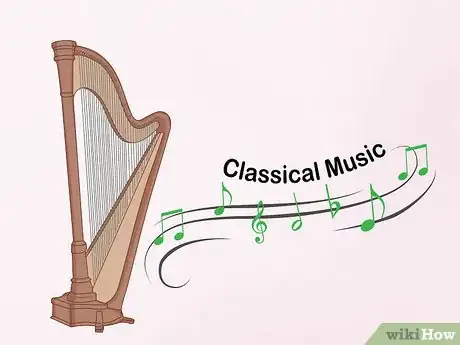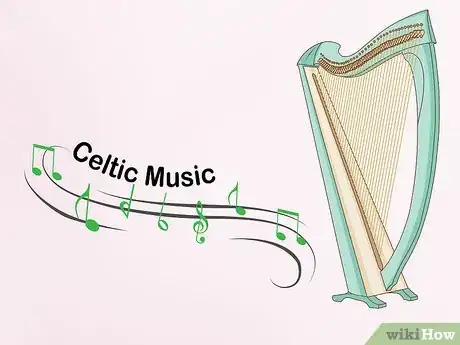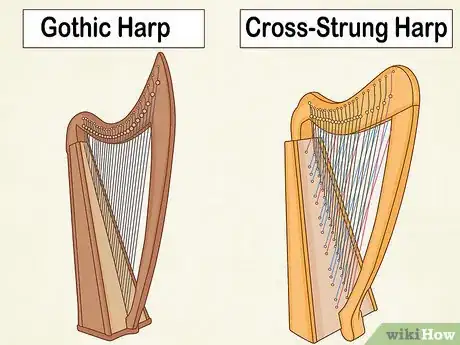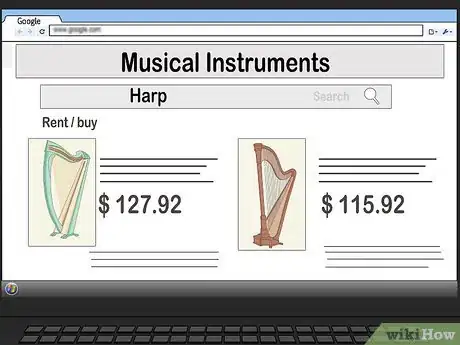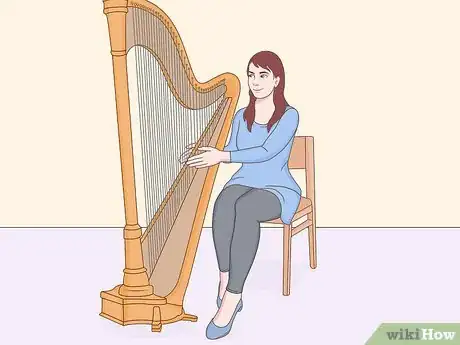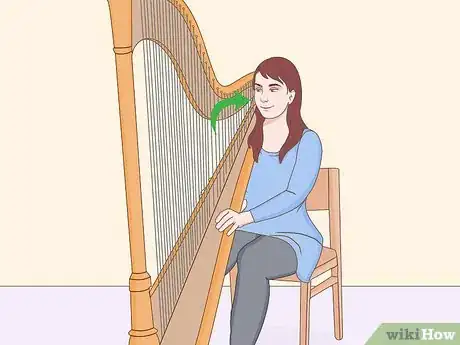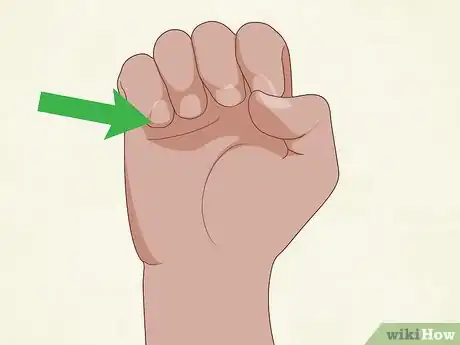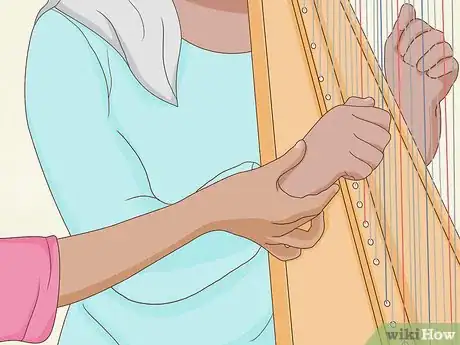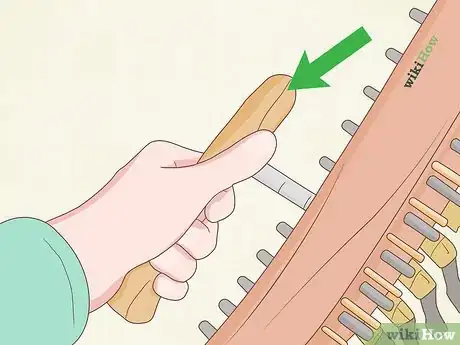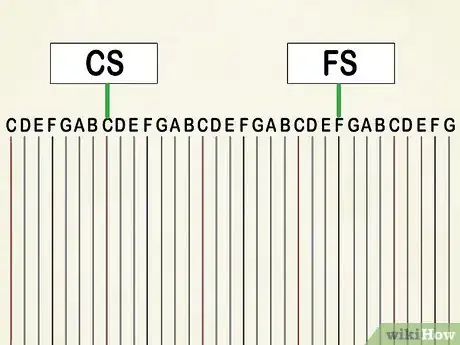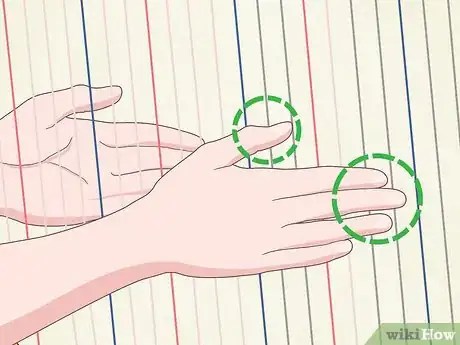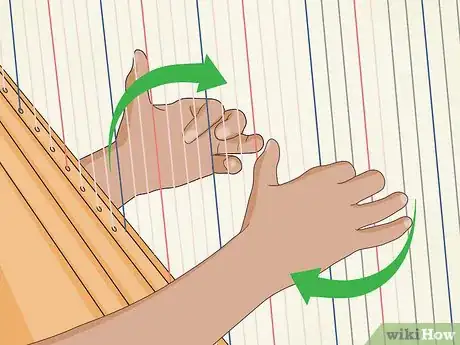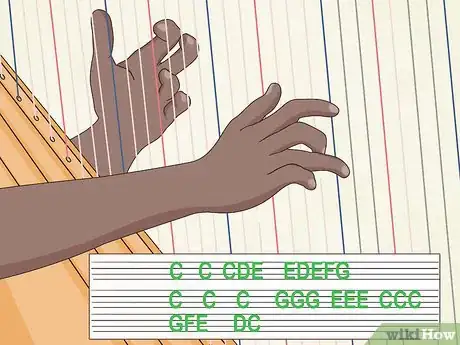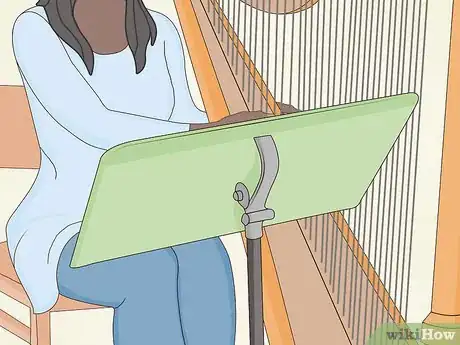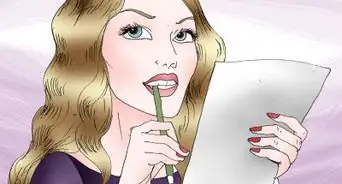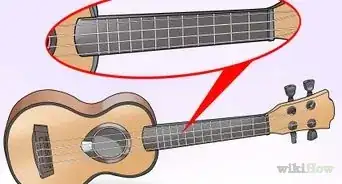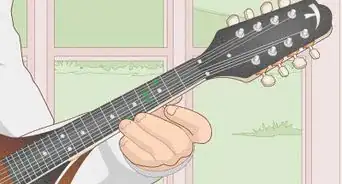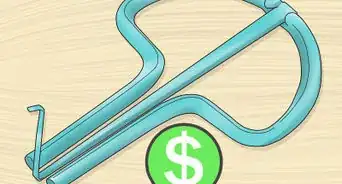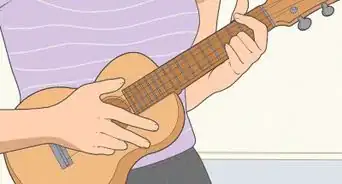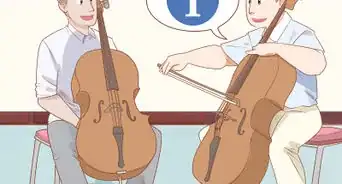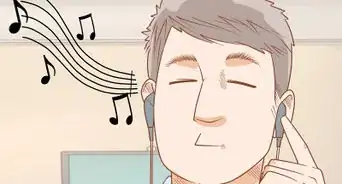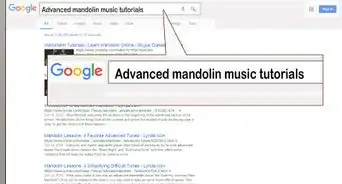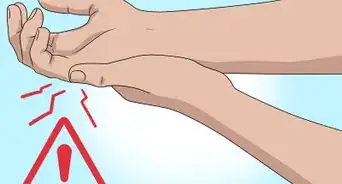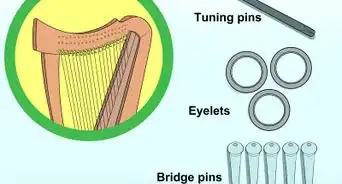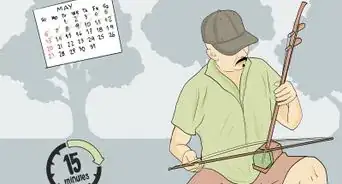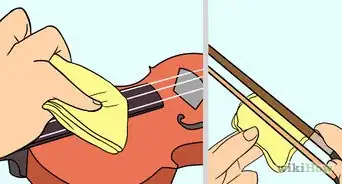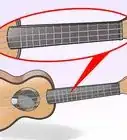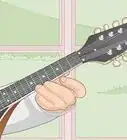This article was co-authored by wikiHow Staff. Our trained team of editors and researchers validate articles for accuracy and comprehensiveness. wikiHow's Content Management Team carefully monitors the work from our editorial staff to ensure that each article is backed by trusted research and meets our high quality standards.
wikiHow marks an article as reader-approved once it receives enough positive feedback. In this case, 82% of readers who voted found the article helpful, earning it our reader-approved status.
This article has been viewed 230,055 times.
Learn more...
The harp is a beautiful instrument that many people admire, but fear they will never be able to play. Learning to play a harp, however, can be achieved with some hard work and knowledge. It is never too late to start learning the harp. There are beginners of all ages and backgrounds who will discover great joy in playing the harp. To play the harp, you should start by choosing a harp and learn how to hold it properly. Once you get the basics down, you can start learning more advanced music.
Steps
Choosing a Harp
-
1Learn about the types of harps. When most people think of a harp, they either picture a large, golden pedal harp in an orchestra, or some type of harp being played by angels on a Christmas card. There are several types of harps, and they come in a variety of forms. The two most common styles of harp are lever harps and pedal harps.[1]
- Lever harps have sharping levers at the top to change the notes.
- Pedal harps have seven pedals that can make notes flat, natural, or sharp.
- There are also wire-strung harps, double-strung harps, triple harps, Aeolian harps and other less common styles.
-
2Determine the type of music you are most interested in playing. This will influence the type of harp you choose. While you can play Celtic music on a pedal harp or a classical piece on a lever harp, these styles of harps are really different instruments for different purposes. If you aren’t sure what type of music you want to play, ask your local music store what type of harp they recommend for absolute beginners.Advertisement
-
3Choose a pedal harp for classical music. This is the type of harp you want if it is your dream to play in an orchestra one day. The pedal harp is loud enough to be heard in an orchestra, and its pedals makes it easier to play the notes classical music requires. It is big, relatively heavy, and has a complicated mechanism that needs periodic adjustment.[2]
- The pedal harp is also one of the most expensive types of harps.
-
4Go for a lever harp if you don’t want to play classical music. You can use a lever harp for classical music, but it is better suited for a modified classical repertoire. The lever harp is often softer and warmer in tone, and it is lighter and more portable. It is also much less expensive than a pedal harp.[3]
- People who like Celtic music often choose Celtic-style lever harps.
-
5Experiment with a less common harp. There are many different types of harps out there. People who perform at Renaissance Fairs may choose a high-headed "Gothic" harp. Some may choose cross-strung, double-strung, or even triple-strung harp if they like to play more unusual music. It’s great to experiment, but it’s best to start with a pedal or lever harp if you’re a beginner.[4]
-
6Buy or rent a harp. Once you’ve chosen the type of harp you want, you will need to obtain a harp to practice on. If you aren’t sure how committed you will be to the harp, you may want to rent a harp at first. You should only buy a harp if you’re serious about it because it’s a costly investment. Even a used pedal harp will cost about $15,000.[5]
- While it is best to be able to play an instrument before purchase, harps can be ordered from reputable harp dealers on the internet. Be wary, however, of some of the inexpensive ($300-$400) harps.
- Only buy antique or used harps with the advice of an experienced harper/harpist. A cheap antique harp may need thousands of dollars of repairs before it can be played.
Holding the Harp
-
1Sit close enough to the harp to comfortably pluck the strings. Sit down in a comfortable, yet solid chair. You should be seated so that your arms are a little below 90 degrees angle with your body. You need to be able to easily play the middle of the harp-strings. The shortest strings should be closest to your body, and the longer strings will be further away from you.[6]
- If you have a lap-harp, you may have to rest its base on a box in front of you.
- The chair that should at a height where you can easily reach the harp.
-
2Tilt the body of the harp between your legs. Tilt it and lean the harp onto your right shoulder. It shouldn't feel too heavy if it is balanced correctly. The harp doesn't have to be straight in front of you. You can turn it sideways a bit so that you can see the strings.[7]
- Your feet should rest on the floor.
-
3Position your hands appropriately. Hand position is a much-debated area among harpers/harpists. There is no one technique that is right for all harpers and harpists. Basically, your hands should be parallel with the floor and in the middle of the strings.[8]
-
4Prevent injuries by relaxing your hands. You may feel the need to tense your hands while plucking the harp strings, but this is not necessary. Relax your hands as often as possible while playing the harp. This is good common sense and will help prevent injuries. Most teachers also emphasize closing the fingers and thumb into the palm after playing a note. This will help you get more sound out of your harp, as well as minimizing injury risk. [9]
Learning to Play
-
1Take lessons from a teacher if possible. It’s ideal to have a professional teach the basics of harp playing. Try to find one who respects the style of music that you wish to play, and who can teach you the appropriate technique for your style of harp. You may also purchase a self-teaching method, like a book or instructional DVD, although this does not replace the knowledge of a teacher.[10]
- You can also watch videos on YouTube to help you learn the basics.
-
2Tune your harp. New harps need to be tuned, and you will have to tune your harp every few times that you play it. You can carefully tighten or loosen the strings to change the notes by using the tuning key that came with the harp. This is an area where an experienced musician will be of great help to you. If you have not acquired a strong ear for music, you can use an electric tuner.[11]
- If you have a pedal harp, be sure that all pedals are disengaged before tuning. Place each pedal in the flat key, which is the top notch.
- If you have a lever harp, be sure all levers are disengaged. With your lever harp, you will probably first tune to the key of C Major.
-
3Take a look at the strings. They are like the keys on a piano: A,B,C,D,E,F,G repeated over and over again. The red strings are Cs, the black or blue strings are Fs. If you can already play the piano, the strings will come more naturally to you, and you will most likely get used to the strings much faster than non-piano players.[12]
-
4Play the harp with your thumb and first three fingers. Most harps are played with the soft sides or tips of your thumb and first three fingers. When playing a lever or pedal harp, fingernails must be kept short unless you want a brassy sound. Wire-strung harps and certain advanced techniques for other harps are played with the fingernails.[13]
-
5Play around with the strings. You do not have to know all of the notes or even know how to read music to produce a beautiful sound on a harp. Using what you know so far, use your fingers to gently pluck the strings. Play around until you feel comfortable with using the harp.[14]
- You will need to learn the notes and read music at some point if you are serious about the harp, but don’t worry about that too much when you are a beginner.
-
6Try a basic glissando. Hold out the thumb of your playing hand. Place it on the harp strings as far as you can reach. Push it quickly away from you in a downward motion so that it slides and makes each string ring out. Then, pull it quickly towards you in an upward motion.[15]
- Be careful not to let your knuckles collapse as you do this, as that will decrease the sound quality.
-
7Attempt a basic tune. A simple song you can try to play is “Row Row Row Your Boat.” First, pluck the “C” string. After you’ve plucked it, close your fingers into your palm, forming a light fist. You will do this after every note you pluck. To play this song, pluck these notes:
- C C CDE EDEFG
- C C C GGG EEE CCC
- GFE DC
-
8Continue learning the basics. Branch out and develop your skill range as you practice. Work on the fundamentals before you attempt more advanced techniques. Eventually, you can work up techniques such as legatos, arpeggios, and harmonics. You can learn a lot on your own, but consider finding someone that is knowledgeable about the harp to help you in the future.[16]
Community Q&A
-
QuestionHow can I play a piece using the pedals?
 Community AnswerThe pedals make the strings become sharp, natural or flat. You use the pedals if the piece calls for sharp, natural or flat notes.
Community AnswerThe pedals make the strings become sharp, natural or flat. You use the pedals if the piece calls for sharp, natural or flat notes. -
QuestionWhy is it so hard to play every day?
 Community AnswerConsistency is difficult and requires a lot of effort. Like any instrument, you need to make a habit of practicing the harp every day in order to become proficient. Even if you just set aside 30 minutes a day to practice, it will help immensely.
Community AnswerConsistency is difficult and requires a lot of effort. Like any instrument, you need to make a habit of practicing the harp every day in order to become proficient. Even if you just set aside 30 minutes a day to practice, it will help immensely. -
QuestionHow does a lever harp work?
 Community AnswerIt works the same as a pedal harp, except that you would flip the levers to control the sharps and flats.
Community AnswerIt works the same as a pedal harp, except that you would flip the levers to control the sharps and flats.
Warnings
- Ask your teacher consult online articles about proper care and maintenance of your instrument. You could damage your harp by improper care.⧼thumbs_response⧽
- Poor hand position or posture may result in an injury. Start with good habits by learning from a professional harp teacher.⧼thumbs_response⧽
Things You'll Need
- Harp
- Harp tuner
- Adjustable bench
References
- ↑ http://www.celticharper.com/what2get.html
- ↑ http://www.celticharper.com/what2get.html
- ↑ http://www.celticharper.com/what2get.html
- ↑ http://www.celticharper.com/what2get.html
- ↑ http://www.celticharper.com/what2get.html
- ↑ https://www.youtube.com/watch?v=uuXdjqGp25o
- ↑ https://www.youtube.com/watch?v=uuXdjqGp25o
- ↑ https://www.youtube.com/watch?v=uuXdjqGp25o
- ↑ https://www.youtube.com/watch?v=uuXdjqGp25o
- ↑ http://www.enjoytheharp.com/Frequently-asked-harp-questions.html
- ↑ http://www.enjoytheharp.com/Frequently-asked-harp-questions.html
- ↑ http://www.myharpsdelight.com/learn-to-play-the-harp/
- ↑ https://www.youtube.com/watch?v=uuXdjqGp25o
- ↑ http://www.myharpsdelight.com/learn-to-play-the-harp/
- ↑ https://www.youtube.com/watch?v=R2PLZp8aujg
- ↑ http://www.harpspectrum.org/harpworks/composing_for_harp/composing_for_harp.shtml
- ↑ http://www.enjoytheharp.com/Frequently-asked-harp-questions.html
About This Article
To play the harp, find a teacher who can give you lessons, or go online to watch YouTube videos to learn the basics. When you’re ready to play, first tune your harp by tightening or loosening its strings as you compare the sounds they make to an electric tuner. Then, sit in a chair, put the harp between your legs so the shortest strings are closest to your body, and tilt the harp so it's leaning against your right shoulder. Finally, put 1 hand on each side of the strings, and use the tips of your thumbs and your first 3 fingers to gently pluck the strings. To learn how to play a simple tune on your harp, keep reading!
